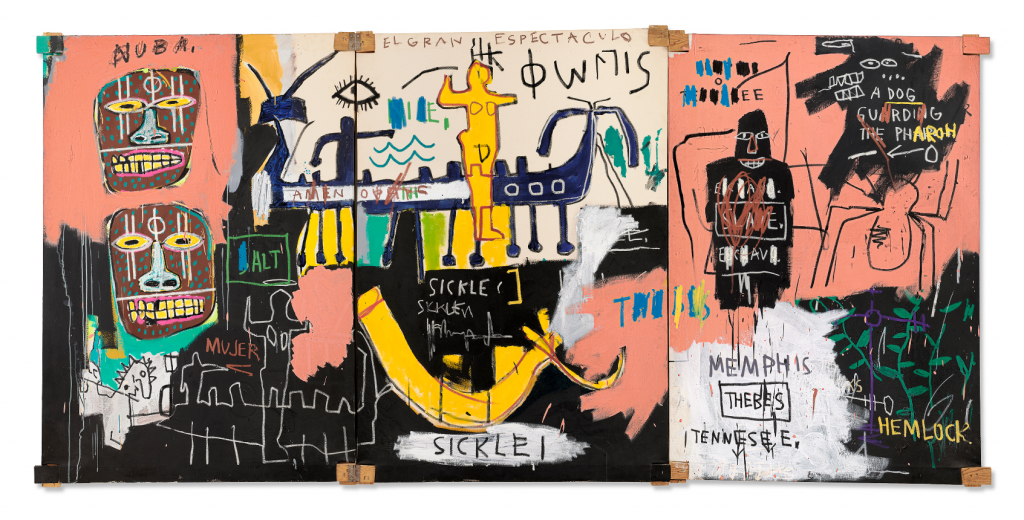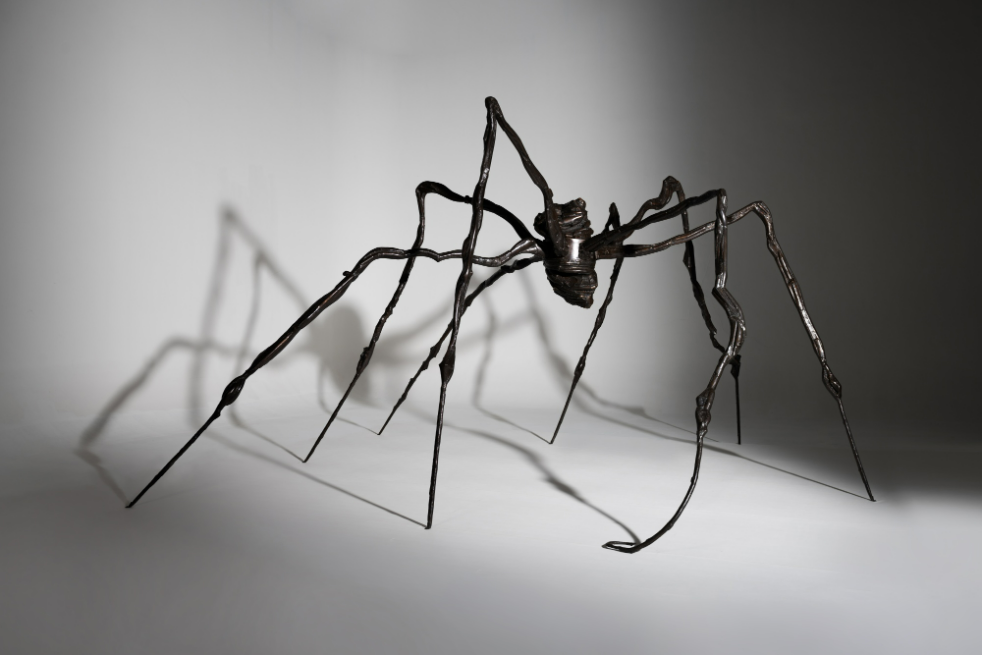Demand for ultra contemporary works may have eased but there is little sign of a sales slump, say the New York firms

Jean-Michel Basquiat, El Gran Espectaculo (The Nile), 1983. Courtesy Christie’s Images Ltd.
New York auction houses are projecting their marquee spring sales could bring in more than $2.2bn, despite worries that the art market may be cooling, both for contemporary work deemed risky by collectors in times of economic uncertainty and for the most expensive works that consignors may be holding back given the uncertain macroeconomic picture. Notably absent this month are any works with nine-figure estimates, or even estimates in the high eights. There is no Georges Seurat masterpiece or Andy Warhol Marilyn portrait or Disaster canvas to test the appetites of the deep-pocketed trophy-hunters, as in recent seasons.
Dealers say that factors such as war, failing banks, an uncertain political outlook and rising interest rates aren’t stopping wealthy collectors from buying art altogether, but acknowledge that the jittery economy may keep them from repeating the record-breaking bids of the past few rounds of major auctions.
“I wouldn’t say that that market is suffering whatsoever. I think it’s still very strong and very stable,” says Emily Kaplan, co-head of Christie’s 20th-century evening sale. “The completely unprecedented auction results that we saw from the last two years may have just tempered slightly.”
Christie’s New York is devoting multiple sales to single-owner collections this month. They include works from the collections of the Chicago commodities trader Alan Press and his wife Dorothy, the late Boston Institute of Contemporary Art trustee Gerald Fineberg, and Sophie Danforth, whose family founded the Rhode Island School of Design. Also headed for the auction block are pieces from the collections of the publishing billionaire SI Newhouse and the Microsoft co-founder Paul Allen. Christie’s estimates that its May sales will bring in between $760m and $1.1bn.

René Magritte, L’Empire des lumières, 1951. Courtesy Sotheby’s.
“To weave a narrative about the collections helps show collectors how special these works are,” Kaplan says.“That’s why we love selling collections, to be able to tell these exciting stories our clients respond to so well.” Last year, Christie’s brought in $1.6bn from two sales of Allen’s collection.
During Christie’s 20th-century evening sale on 11 May, Burning Gas Station (1966-69) by Ed Ruscha from the Press collection is estimated to sell for between $20m and $30m. It is only the second painting from Ruscha’s Stations series to appear at auction, according to Christie’s.
“For me, that’s the work that signifies the entire last industrial revolution and the whole 20th century,” says the art adviser Lisa Schiff, who founded the New York-based firm SFA Art Advisory. “I hope somebody really spectacular gets it, and I hope it goes high.”
Christie’s is also focusing on highlighting women artists and promoting their markets, Kaplan says. Half of the lots in its 21st-century auction on 15 May are by women.
Kaplan adds: “The market is generally quite aware that works by female artists and artists of colour have been undervalued. A lot of collectors are both looking at that as a smart investment… and wanting to focus on a wider variety of artists and make sure their collection is more representative.”
Monumental Basquiats
Christie’s 21st-century evening sale is led by Jean-Michel Basquiat’s El Gran Espectaculo (The Nile) (1983), a massive canvas that is expected to fetch around $45m. It is not the only monumental Basquiat work up for sale this season. Three nights later, Sotheby’s New York is offering Now’s the Time (1985), Basquiat’s rendition of the jazz legend Charlie Parker’s 1945 record of the same name. Sotheby’s estimates the painting will sell for around $30m in its auction debut, after spending decades in the collection of the magazine publisher Peter Brant, the only person to have owned the painting. It is among the most valuable works being offered this month by Sotheby’s, which anticipates its May sales figures will hit between $732.3m and $1bn.

Louise Bourgeois, Spider, 1996. Photo by Edouard Fraipont, courtesy Sotheby’s.
During the same contemporary art evening sale, Sotheby’s is offering a ten-foot tall Spider (1996) by Louise Bourgeois that will likely break at least one auction record. Its estimate of between $30m and $40m is the highest ever for a Bourgeois work, Sotheby’s says. If it sells for the low end of the estimate, it will likely become the most valuable Bourgeois work to sell at auction, beating the $28m ($32.1m with fees) another version ofSpider (1996) fetched at Christie’s in May 2019. If the sculpture’s price rallies toward the high end of its estimate, it stands to compete with the record for any work by a woman at auction, currently held by Georgia O’Keeffe’s Jimson Weed (1936), which the Walmart heiress Alice Walton purchased for $44.4m (with fees) in 2014.
Insel im Attersee (1901-02), a rare lake landscape by Gustav Klimt, is expected to fetch around $45m for Sotheby’s during the auction house’s modern art evening auction on 16 May. Another top lot for the sale is Peter Paul Rubens’s Portrait of a Man as the God Mars (around 1620), estimated at between $20m and $30m. The painting comes from a group of works caught up in a complicated divorce between the former Metropolitan Museum of Art trustee Mark Fisch and the former judge Rachel Davidson. Ten other Baroque paintings from their collection—including another Rubens—brought in a combined $49.5m with fees at Sotheby’s earlier this year.

Gustav Klimt, Insel im Attersee, 1901-02. Courtesy Sotheby’s.
A dedicated evening auction and a sequence during a contemporary art day sale have been set aside by Sotheby’s for the collection of the late Warner Bros music executive Mo Ostin, whose works by René Magritte, Cy Twombly, Willem de Kooning, Basquiat, Joan Mitchell, Cecily Brown, Takashi Murakami and Pablo Picasso are estimated to bring in more than $120m.
At Phillips, the auction house’s sole evening sale will be led by Banksy’s Banksquiat. Boy and Dog in Stop and Search (2018), a painting the pseudonymous British artist made in response to a 2017 Basquiat show in London. On a wall near the Barbican Centre, where the show was held, Banksy spray-painted a figure inspired by Basquiat’s painting Boy and Dog in a Johnnypump (1982) being frisked by two London police officers. This version on canvas, released by Banksy the following year, is estimated to sell for between $8m and $12m. The painting is the most valuable work on offer this month at Phillips, which expects to bring in between $92.5m and $133m over an evening and two day sales.
During the same evening sale as the Banksy, two early Yayoi Kusama sculptures, Red Stripes (1965) and Blue Spots (1965), are estimated to fetch between $2.5m and $3.5m each. Kusama is one of the most globally beloved living artists—and the subject of an ongoing collaboration with Louis Vuitton, the world’s largest luxury brand—but her early work is still “extremely rare” at auction, says Robert Manley, the deputy chairman of Phillips and its worldwide co-head of 20th-century and contemporary art. It is extraordinary for the auction house to be offering two at one time, he adds, pointing out that Kusama was proud enough of the two works to be photographed standing in front of the sculptures multiple times.
‘Her market couldn’t be stronger’
“It’s just one of these wonderful moments when art history and the art market are in alignment, because her market couldn’t be stronger,” Manley says. Last year, Phillips set Kusama’s auction record when her painting Untitled (Nets) (1959) sold for $10.5m with fees.
While the auction houses are optimistic about this month’s sales, some collectors are showing more caution when it comes to buying art, dealers say. The latest Art Basel and UBS Art Market report, released last month, found auction sales fell last year by 2% to $30.6bn (including both public and private sales), in large part because of low rates of participation in China after Covid-19 lockdowns stalled autumn sales. The high end of the auction market was the most resilient, with works priced above $10m rising in value by 12%—the only part of the business to increase last year, according to the report.
In times of economic uncertainty, wealthy collectors tend to focus on buying work by more established artists whom they believe pose less of an investment risk than the trendy contemporary artists whose works have inspired speculative frenzies in recent years. While auction houses and dealers say they have observed a sense of slowness among collectors amid uncertain market factors, they don’t anticipate it disrupting May auctions.
“People have been quick to herald the impact of a recession and the idea of the art market failing,” says Lucius Elliott, who leads Sotheby’s The Now sale, dedicated to art created in the previous two decades. “Based on the interest we have from third-party guarantors and preliminary interest already, it doesn’t feel like a bearish market.” Even so, he adds, there has been a “softening” in some sectors of the market.
Compared to the previous few years, Manley says, buyers are “being a little more selective”. As a result, the market may be “a little bit less frothy”.
Source: The Art Newspaper







